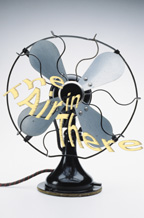
In the early '90s, I was involved with the restoration of the famous Guggenheim Museum in New York City. Built in the late '50s, architect Frank Lloyd Wright was heard to respond to the general contractor's inquiry as to whether or not his name could be placed alongside his on the building's cornerstone: "George, a round building doesn't have a cornerstone."
As the prime subcontractor for the restoration, we were plaster skim-coating all the interior surfaces and providing new rigid insulation directly to the outer (exterior) curved wall of the spiral ramp where the artwork is exhibited. This insulation was being installed with an adhesive that proved to be extremely toxic. One of the workmen installing the insulation was overcome by the fumes from the adhesive when applied to the insulation and was taken by ambulance to the hospital.
After this incident, all workmen were required to wear respirators and clerestory windows along the perimeter of the ramp were removed to provide adequate ventilation during the installation of the insulation and curing of the adhesive. It was a valuable lesson for me and all parties involved about the dangers posed by certain materials on the construction site. It also leads into our topic for this month.
Full fathom five
Five fundamental categories encompass the process of building green.1. Energy efficiency.
2. Indoor air quality.
3. Resource conservation.
4. Environmentally responsible technology.
5. Construction, operations and maintenance procedures.
Based on my experience at the Guggenheim, and, for our continuing discussion of environmentally conscious construction and how it affects the walls and ceiling industry, let's take an in-depth look at the second fundamental category, indoor air quality.
As contractors, we have much choice regarding the selection and use of a variety of materials and finishes. Unfortunately, many times these choices can and do have an adverse effect upon the air quality of a building. Toxic sealants and adhesives, vinyl wall coverings, stain-resistant treatments and foam-backed materials all can have detrimental effects on air quality. Fortunately, a contractor can do several things to dramatically improve air quality. Here are some suggestions.
Toxic materials: Use manufactured products containing formaldehyde, halogenated solvents, mercury/mercury compounds, pigments using lead, cadmium and/or chromium, aromatic hydrocarbons, pesticides and preservatives, etc., minimally, or, more preferably, not at all.
Paint: Although they have a limited shelf life and are two- to two-and-one-half times the cost of standard latex paint, choose low biocide paints. They do not contain the fungicides and mildewcides typically added to latex paint to extend shelf life. Also, choose paints that provide durable and washable surfaces whenever possible.
Hazardous materials: Like toxic materials, use hazardous materials minimally or eliminate them from use. For example, fiberglass insulation is considered to be a risk due to the fiber's ability to become an airborne inhalant, similar to asbestos. Cellulose insulation contains inks that may "out gas" formaldehyde into a living space (a vapor barrier should always be provided between a living space and cellulose insulation). Try borate-treated cellulose insulation instead. Borate is based on the naturally occurring mineral boron and is now being used in the pressure treatment of wood in lieu of arsenic.
Rigid insulation: Many types of rigid expanded polystyrene insulation board contain chrlorofluorocarbons or hydrogenatechlorofluorocarbons. These types of rigid board insulation release chlorine molecules (HCFCs to a lesser degree than CFCs) contributing to atmospheric ozone depletion. Avoid both types. Cemetitious foam, rockwood and perlite insulation are considered the least hazardous types of insulation currently available.
Coordination: Sequence construction to include installation of wet materials first, giving them time to cure and for chemical "off gassing" to occur. Dry materials like acoustical ceiling tiles absorb contaminants from materials curing during construction and then re-release these chemical contaminants over time, contributing to the "sick building syndrome." Use chemically stable solvents, adhesives and organic compounds that minimize "off gassing." During the application of paints and coatings, coordinate air purging periods using 100-percent outside air prior to floor/building occupancy.
Material selection: Select paints, coatings, adhesives, solvents, cleaners, lubricants and other fluids that are:
o Water soluble/cleanable.
o Non-carcinogenic.
o Non-flammable.
o Biodegradable.
o Without chlorinated hydrocarbons.
o Made with low or zero volatile organic compound content.
As you can see, much can be done to create and maintain a better-built environment for all to enjoy. As wall and ceiling contractors, we play an important part in this process. Next time, we'll take a look at another important aspect of building green and how it affects our industry.

Report Abusive Comment